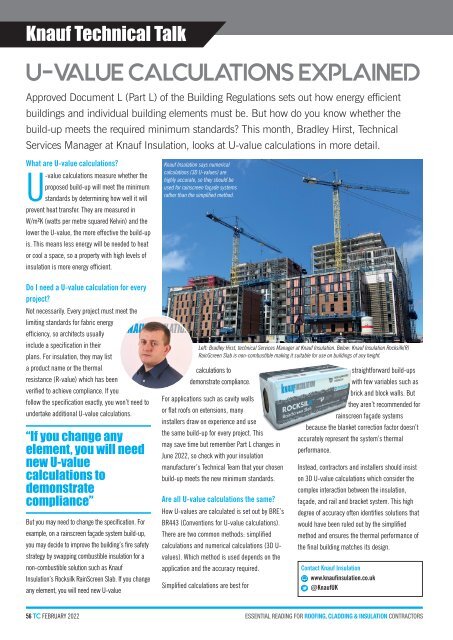February 2022
Create successful ePaper yourself
Turn your PDF publications into a flip-book with our unique Google optimized e-Paper software.
Knauf Technical Talk<br />
U-VALUE CALCULATIONS EXPLAINED<br />
Approved Document L (Part L) of the Building Regulations sets out how energy efficient<br />
buildings and individual building elements must be. But how do you know whether the<br />
build-up meets the required minimum standards? This month, Bradley Hirst, Technical<br />
Services Manager at Knauf Insulation, looks at U-value calculations in more detail.<br />
What are U-value calculations?<br />
U-value calculations measure whether the<br />
proposed build-up will meet the minimum<br />
standards by determining how well it will<br />
prevent heat transfer. They are measured in<br />
W/m²K (watts per metre squared Kelvin) and the<br />
lower the U-value, the more effective the build-up<br />
is. This means less energy will be needed to heat<br />
or cool a space, so a property with high levels of<br />
insulation is more energy efficient.<br />
Knauf Insulation says numerical<br />
calculations (3D U-values) are<br />
highly accurate, so they should be<br />
used for rainscreen façade systems<br />
rather than the simplified method.<br />
Do I need a U-value calculation for every<br />
project?<br />
Not necessarily. Every project must meet the<br />
limiting standards for fabric energy<br />
efficiency, so architects usually<br />
include a specification in their<br />
plans. For insulation, they may list<br />
a product name or the thermal<br />
resistance (R-value) which has been<br />
verified to achieve compliance. If you<br />
follow the specification exactly, you won’t need to<br />
undertake additional U-value calculations.<br />
“If you change any<br />
element, you will need<br />
new U-value<br />
calculations to<br />
demonstrate<br />
compliance”<br />
But you may need to change the specification. For<br />
example, on a rainscreen façade system build-up,<br />
you may decide to improve the building’s fire safety<br />
strategy by swapping combustible insulation for a<br />
non-combustible solution such as Knauf<br />
Insulation’s Rocksilk RainScreen Slab. If you change<br />
any element, you will need new U-value<br />
Left: Bradley Hirst, technical Services Manager at Knauf Insulation. Below: Knauf Insulation Rocksilk(R)<br />
RainScreen Slab is non-combustible making it suitable for use on buildings of any height.<br />
calculations to<br />
demonstrate compliance.<br />
For applications such as cavity walls<br />
or flat roofs on extensions, many<br />
installers draw on experience and use<br />
the same build-up for every project. This<br />
may save time but remember Part L changes in<br />
June <strong>2022</strong>, so check with your insulation<br />
manufacturer’s Technical Team that your chosen<br />
build-up meets the new minimum standards.<br />
Are all U-value calculations the same?<br />
How U-values are calculated is set out by BRE’s<br />
BR443 (Conventions for U-value calculations).<br />
There are two common methods: simplified<br />
calculations and numerical calculations (3D U-<br />
values). Which method is used depends on the<br />
application and the accuracy required.<br />
Simplified calculations are best for<br />
straightforward build-ups<br />
with few variables such as<br />
brick and block walls. But<br />
they aren’t recommended for<br />
rainscreen façade systems<br />
because the blanket correction factor doesn’t<br />
accurately represent the system’s thermal<br />
performance.<br />
Instead, contractors and installers should insist<br />
on 3D U-value calculations which consider the<br />
complex interaction between the insulation,<br />
façade, and rail and bracket system. This high<br />
degree of accuracy often identifies solutions that<br />
would have been ruled out by the simplified<br />
method and ensures the thermal performance of<br />
the final building matches its design.<br />
Contact Knauf Insulation<br />
www.knaufinsulation.co.uk<br />
@KnaufUK<br />
56 TC FEBRUARY <strong>2022</strong>

















